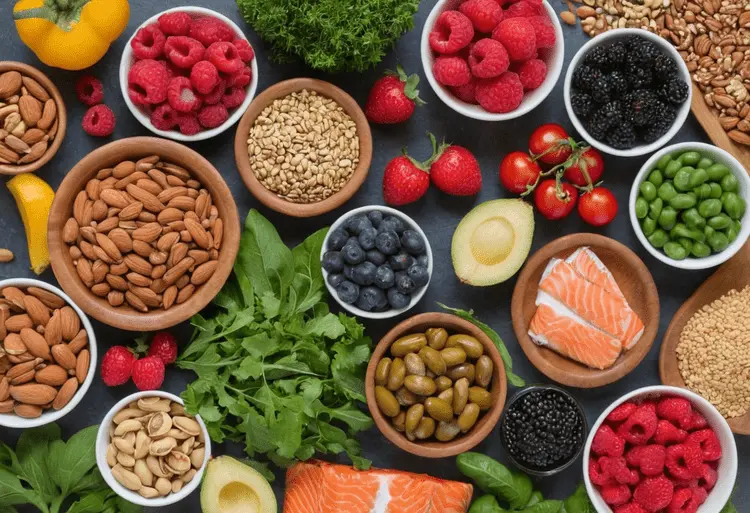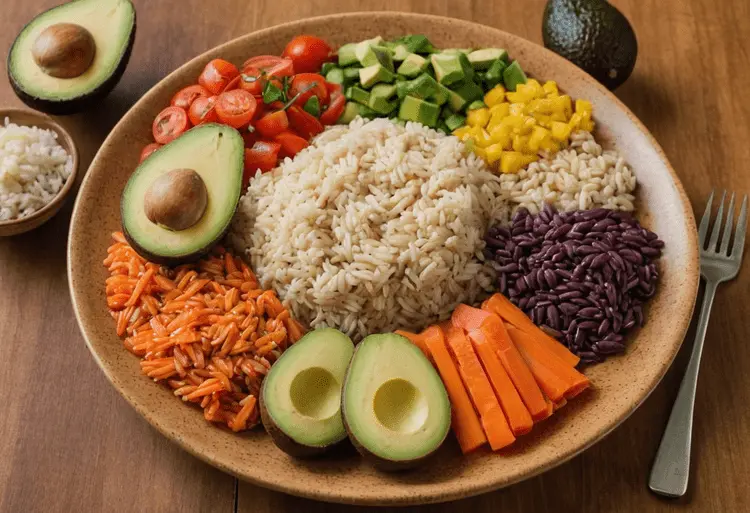Finding an effective diet chart for PCOD can feel overwhelming. If you have PCOD (Polycystic Ovarian Disease), you understand the struggle of managing frustrating symptoms like irregular periods, weight gain, and acne.
You’ve likely searched for a diet chart for PCOD or a PCOS diet seeking answers. There’s so much confusing information out there, it’s hard to know what really works.
The good news is, the right “Nutrition for PCOS” plan can make a huge difference! A healthy PCOD diet plan isn’t just about what you can’t eat. It focuses on delicious Foods for PCOD that nourish your body and help regulate your hormones. Ready to take control of your health? This ultimate guide will show you how.
PCOD Diet Basics: At a Glance
- Focus on whole foods
- Choose lean protein
- Include healthy fats
- Limit refined carbs
- Manage portion sizes
- Consider consulting a dietitian
Table of contents
Understanding PCOD & the Power of Diet

Introduction
Have you been diagnosed with PCOD (Polycystic Ovarian Disease)? Are irregular periods, frustrating acne, and difficulty managing your weight a constant struggle? If so, you’re not alone.
PCOD is a complex hormonal condition that affects millions of women worldwide. But here’s the good news: diet plays a powerful role in managing your symptoms and improving your overall health.
What is PCOD?
PCOD is a hormonal disorder that throws your body out of whack. Typical symptoms include:
- Irregular periods
- Excess hair growth (hirsutism)
- Acne
- Weight gain or difficulty losing weight
Long-term, unmanaged PCOD can increase your risk of serious health issues like diabetes, heart disease, and infertility.
The Impact of Diet Chart for PCOD
Think of food as medicine when you have PCOD. What you eat can either fuel the hormonal imbalances or help bring your body back into balance. A key culprit in PCOD is insulin resistance.
- Insulin resistance: This means your body has trouble using the hormone insulin effectively, leading to high blood sugar levels and, often, weight gain.
- Inflammation: Certain foods can trigger inflammation, making your PCOD symptoms worse.
The good news is, choosing the right foods as part of a PCOD diet chart can make a big difference. It’s about working with your body, not against it.
The PCOD Diet Blueprint
Ready to make positive changes? Here’s your roadmap to a PCOD-friendly eating plan. Think of it as building a strong foundation, not a restrictive diet.
Dietary Principles for PCOD Management
- Prioritize whole, unprocessed foods. Think fresh fruits, vegetables, and whole grains. These nourish your body and manage blood sugar levels.
- Focus on fiber. It keeps you full, promotes healthy digestion, and helps regulate hormones. Aim for beans, lentils, veggies, and whole grains.
- Choose lean protein. Fish, poultry, tofu – these powerhouses help build muscle and balance blood sugar.
- Don’t fear healthy fats. Avocados, nuts, olive oil – they’re essential! These good fats enhance satisfaction and support hormone balance.
- Mind your portions. Even healthy foods need moderation. Is overeating a challenge? Discuss strategies with a registered dietitian specializing in PCOD.
Diet Chart for PCOD –Foods to Embrace
Want a vibrant shopping list for your PCOD diet chart? Let’s dive in!
- Leafy green vegetables: Spinach, kale, loaded with nutrients vital for hormone health.
- Colorful fruits: Especially berries, which are naturally low in sugar and packed with antioxidants.
- Legumes and beans: Great sources of protein, fiber, and essential nutrients.
- Nuts and seeds: A delicious way to boost healthy fats, protein, and fiber.
- Fatty fish: Think salmon, tuna, rich in omega-3 fatty acids that fight inflammation.
- Anti-inflammatory spices: Turmeric, ginger, add flavor and potent health benefits.
Diet Chart for PCOD –Foods to Limit or Avoid
These foods can disrupt your hormones and make PCOS symptoms worse. Is completely cutting them out necessary? That’s where a PCOS Nutrition Center specialist can guide you in creating a sustainable plan.
- Refined carbohydrates: Think white bread, pasta, pastries – they cause blood sugar spikes.
- Sugary drinks and processed snacks: These contribute to inflammation and weight gain.
- Excess red meat: Opt for leaner options more frequently.
- Fried foods: They increase inflammation and can worsen insulin resistance.
- High-fat dairy: Consider alternatives if dairy seems to worsen your symptoms.
- Artificial sweeteners: More research is needed on their long-term effects with PCOD.
Let me know if you’d like a sample PCOD diet chart. I’m happy to provide one! Also, what are your favorite PCOD-friendly recipes? Share them below or tag us on social media!
Did you know that protein plays a crucial role in managing PCOD and promoting weight loss? Discover the power of protein and check out this list of delicious, satisfying protein sources to help you feel your best…
Creating Your Ideal PCOD Meal Plan

Ready to put those PCOD-friendly foods into action? Let’s design a meal plan that works for you. After all, managing PCOD isn’t one-size-fits-all.
Sample Meal Ideas
Think of these as inspiration, not a rigid rulebook. Your perfect PCOD meal might look different, and that’s great!
- Breakfast:
- Oatmeal with berries and nuts
- Whole-grain toast with avocado and an egg
- Green smoothie with protein powder
- Lunch:
- Big, colorful salads with grilled chicken or fish
- Whole-wheat wraps filled with lean protein and veggies
- Lentil soup with a side of fruit
- Dinner:
- Baked salmon with roasted vegetables
- Turkey chili with brown rice
- Veggie stir-fry with tofu or tempeh
Customizing Your Plan
Is your sweet tooth screaming for attention? Do you hate the taste of fish? No worries! A sustainable PCOD diet chart is all about finding what works for YOU. Consider these factors:
- Food Preferences: Don’t force yourself to eat things you dislike. Find healthy swaps that you enjoy.
- Dietary Restrictions: Food allergies or intolerances? There are plenty of delicious PCOD-friendly options.
- Calorie Needs: Weight management is a goal? Talk to a registered dietitian specializing in PCOD.
Beyond Food: Lifestyle Matters
A healthy diet chart for PCOD is amazing, but it’s not the whole picture. Think about incorporating:
- Regular Exercise: Aim for at least 30 minutes of moderate-intensity exercise most days.
- Stress Management: Yoga, meditation, or spending time in nature can be incredibly helpful.
- Quality Sleep: 7-8 hours a night is crucial for hormone balance.
Tackling Challenges & Staying Motivated
Dealing with Cravings
Change is hard, especially when it comes to food! Do those sugary snacks or late-night treats keep calling your name? It’s completely normal to experience cravings, but is giving in your only option?
Absolutely not! Here’s how to manage cravings and stay focused on your PCOD diet chart:
- Identify Your Triggers: Are you reaching for comfort foods when stressed or bored? Understanding your triggers is the first step to finding healthier coping mechanisms.
- Healthy Swaps: Have a craving for something sweet? Reach for a handful of berries or a piece of dark chocolate.
- Mindful Indulgence: Enjoy occasional treats in moderation. Planning them will prevent impulsive snacking.
Dining Out with PCOD
Eating out doesn’t have to derail your progress! Navigating restaurant menus can feel daunting, but it’s possible to make smart choices. Here’s how:
- Plan Ahead: Look up the restaurant’s menu online beforehand. Identify a few potential dishes that fit your ‘diet chart for pcod’.
- Ask Questions: Don’t be afraid to ask your server about ingredients and preparation methods. A little communication can ensure a PCOD-friendly meal. Many restaurants are increasingly mindful of dietary needs – you might be surprised!
- Prioritize Protein and Veggies: Look for lean protein options like grilled chicken or fish, paired with plenty of vegetables. Customize your meal and ask for extra veggies instead of fries or rice.
The Importance of Support
Managing PCOD can feel like a solo journey, but you don’t have to go it alone. Seeking support is crucial for staying motivated.
- Find Your Friends: Connect with others who understand your experiences. Online communities or support groups (like those offered on the PCOS Nutrition Center) can be invaluable.
- Professional Guidance: Seek help from a registered dietitian specializing in PCOD. They can provide the personalized advice and accountability you need to succeed.
Let me know how you’re doing! Feel free to share your challenges and victories. Tag me on social media – I’m here to cheer you on!
Conclusion

So, where do you go from here? Have you found yourself inspired to make positive changes to your diet after exploring the possibilities of a PCOD-focused diet chart? Are you recognizing the power food has in managing your symptoms?
Ultimately, your ideal PCOD diet is about progress, not perfection. It’s finding what works for your body and your lifestyle.
It might mean seeking personalized support from a registered dietitian specializing in PCOS – a smart investment in your health. And hey, if you find a recipe that helps you feel amazing, be sure to let us know!
Remember, knowledge is power. Discover more about how food can impact your hormones and PCOS journey at the PCOS Nutrition Center. They’ve got loads of helpful info! Plus, remember you’re not alone! Join the conversation over at the PCOS Awareness Association for a supportive community.
- Focus on whole foods: Think less about restrictions, more about vibrant, nourishing choices.
- Listen to your body: It has wisdom when it comes to hunger, fullness, and food cravings.
- Don’t give up: Sustainable change takes time and kindness towards yourself.
The ‘Eat This, Not That’ approach helped you manage PCOD – now discover a powerful new way to transform your health with the 90-30-50 Diet Plan.
Your PCOD Diet Questions Answered
There’s no one-size-fits-all PCOD diet chart. Focus on whole foods, fiber-rich options, lean proteins, and healthy fats. A registered dietitian can help you create a personalized plan.
Limit or avoid refined carbohydrates (white bread, pastries), sugary drinks, excessive red meat, fried foods, and high-fat dairy products.
While weight loss is possible with PCOD, rapid weight loss may be unrealistic. Focus on sustainable changes for long-term success. Consult a doctor or dietitian for safe weight loss guidance.
Brown rice is a better option than white rice due to its higher fiber content. However, portion control is still important for managing blood sugar levels.
Yes! A healthy PCOD diet can promote weight loss by managing blood sugar and insulin levels.
Talk to your doctor or a registered dietitian. They can determine if supplements could benefit you.
Absolutely! Explore resources like the PCOS Nutrition Center and Pinterest for delicious PCOD-friendly recipes.
Focus on balance! Enjoy occasional treats in moderation, and remember that progress is more important than perfection.
A healthy diet can improve these symptoms by helping to regulate your hormones.